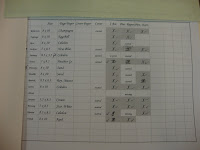One school, though, has identified and is successfully using methods for teaching and encouraging publishing as a key component of the writing process. Designed and operated by Mrs. Molly Millman, The Alexander Dawson School at Rainbow Mountain (Las Vegas, Nevada) sports a model publishing center. Called the BEAR ("Bringing Exceptional Authors Recognition") program and situated in the school's library, the mission of the publishing center is "to support Dawson student authors, poets, and artists in their quest for independent and collaborative skills necessary to be successful in the next century."
Using a self-designed curriculum, Mrs. Millman teaches content including publishing form, process, resources, authorship, communication, and presentation based on the philosophy: "BEAR Publishing, through collaboration efforts in project design, small and large group instruction, and teacher support, extends and enriches the positive impact of writing and publishing activities."







 In addition, Mrs. Millman provides students with visual models demonstrating margins. This assists them in understanding what is meant by top, bottom, left, and right margins within the context of
In addition, Mrs. Millman provides students with visual models demonstrating margins. This assists them in understanding what is meant by top, bottom, left, and right margins within the context of






Though she engages in group instruction in students' classrooms, most publishing occurs in small group settings in the publishing center. After typing their projects during regular class or computer time, students format and add graphics to their projects with Mrs. Millman.

This first graphic shows the method Mrs. Millman uses to organize student projects. Because students progress at different rates, she organizes each class by project and sub-requirement within the project. In this way, she is able to assist students individually.

This second graphic shows an example of a project students completed in their classrooms. In this case, the student wrote and typed a report on Thomas Jefferson. After typing the report, Mrs. Millman taught the student to place a transparent graphic in the background. When it came time to publish a student book, she introduced modifying the text, picture, and page layout to nicely align with the student's selected book size and type.
Students determine the ultimate format for their projects. In most cases, the projects appear in book format—often as anthologies. In some cases, students or classes complete their own books such as poetry anthologies or original stories. They scan their own artwork and add it to student-made content books. For instance, when visiting authors work with students on story development, students create both the text and pictures for an original story and organize their creations to ultimately publish a completed, professional-looking bound book. Other times, publishing accompanies content other than language arts. For example, during a unit on Colonial America, small groups of students design and create a book with sections on each of the different colonies.

One of the key components of each of the books is an author page. Younger students use a template to prepare the content for their author page. Upon publishing their book, all students receive copies to revisit throughout their lives and share with their families.

Before students begin computer work on their projects, they choose the paper color they wish to use on their book cover and for all body pages. The Dawson Publishing Center contains a wide variety of paper qualities and colors. Students also select their book size.

To assist in selecting papers, paper sizes, and fonts, Mrs. Millman provides students with sample options.


 In addition, Mrs. Millman provides students with visual models demonstrating margins. This assists them in understanding what is meant by top, bottom, left, and right margins within the context of
In addition, Mrs. Millman provides students with visual models demonstrating margins. This assists them in understanding what is meant by top, bottom, left, and right margins within the context of their selected paper size.


When it is time for binding, students may use comb or hand binding methods. The Publishing Center has a comb binding machine and wide variety of comb sizes and colors.

If students choose to hand bind their books, Mrs. Millman assists through the process of punching holes (with the help of a self-designed guide showing where the holes should go) and selecting ribbon. She provides them with a sample of a completed book and walks them through the binding and tying process.



At the end of this process, students have mastered myriad computer and publishing skills and have a quality take-home product. She notes that after repeating the process approximately three times, elementary-aged children are able to complete most of these skills independently.
________________________
**This information is shared with Mrs. Millman's permission. Please cite her for this work, and do her the honor of letting her know if you choose to incorporate any of these ideas in your teaching. It is with great respect that I offer these resources in her name. What a pleasure to learn from such a talented educator!
No comments:
Post a Comment